Review of “You are a Social Detective! Explaining Social Thinking to Kids” written by Michelle Garcia Winner and Pamela Crooke, illustrated by Kelly Knopp
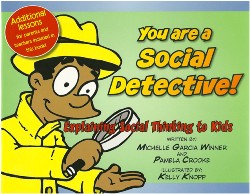 Getting started with the Social Thinking Curriculum by Michelle Garcia Winner is always a challenge. Most of us, Speech-Language Pathologists, fall under two distinct categories: 1) “Read first Therapists” that like to read and study a program until it we can recite it in our sleep before we will begin to implement it on our students, 2) “Try it out first Therapists” that will try to figure out the program while we implement it on our students.
Getting started with the Social Thinking Curriculum by Michelle Garcia Winner is always a challenge. Most of us, Speech-Language Pathologists, fall under two distinct categories: 1) “Read first Therapists” that like to read and study a program until it we can recite it in our sleep before we will begin to implement it on our students, 2) “Try it out first Therapists” that will try to figure out the program while we implement it on our students.
I belong to the former category. I spent months after my first Social Thinking conference buying various books and studying them. After all that extensive reading, I concluded that, “You are a Social Detective!” was arguably one of the best programs to initiate the Social Thinking curriculum. This is possibly also because a majority of my caseload includes pre-school and early elementary students. It uses a comic book form and introduces many of the social thinking vocabulary in a clear and systematic way.
The first section points out how we all have school smarts, sports smarts, Lego smarts, etc. but we also have social smarts. It explains that social smarts means understanding that others have thoughts about us and we have thoughts about others. We use social smarts everywhere.
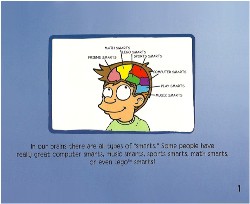
Some of the social thinking vocabulary that is explained using simple but age appropriate illustrations include “being a part of a group,” “thinking with our eyes,” “expected and unexpected behaviors.” The program uses the same social situation to contrast expected and unexpected behaviors, making it easier for children to grasp the concept.
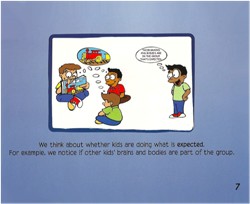 Versus
Versus 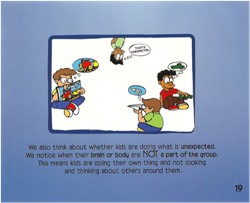
The book introduces the concept of “having uncomfortable thoughts,” which, in my opinion is more appropriate and specific than using “feeling mad or angry,” especially for children on the spectrum. Feeling angry is so broad and vague and encompasses so many different scenarios and situations, that it makes it challenging for children on the Autism Spectrum. “Having uncomfortable thoughts” directly links the person’s thoughts to the student’s behavior.
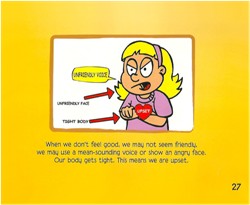 The book also explains “being upset” in explicit physical terms (mean sounding voice, angry face, body gets tight) so children can identify their own states when they get upset.
The book also explains “being upset” in explicit physical terms (mean sounding voice, angry face, body gets tight) so children can identify their own states when they get upset.
The book then goes on to explain the process of being a social detective, i.e. using eyes and ears along with what they know in their brains. The authors talk about how we use our eyes, ears and brain to make “Smart Guesses” about how to behave. The contrast (Whacky Guess) is also illustrated.
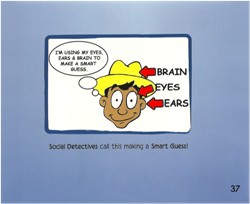 Another challenge a lot of my little ones have is identifying and differentiating between peers who are nice and friendly and others who say or do mean things. The book has tables (page 44 and 45) to help the child identify and list characteristics of a “nice person” and a person who is “not nice to talk to.” In addition, the book also has a glossary with definitions of the Social Thinking vocabulary for quick reference. The book also includes three lesson plans at the end of the book for “Expected Vs Unexpected Behaviors,” “Social Spy,” and “Social Detective.”
Another challenge a lot of my little ones have is identifying and differentiating between peers who are nice and friendly and others who say or do mean things. The book has tables (page 44 and 45) to help the child identify and list characteristics of a “nice person” and a person who is “not nice to talk to.” In addition, the book also has a glossary with definitions of the Social Thinking vocabulary for quick reference. The book also includes three lesson plans at the end of the book for “Expected Vs Unexpected Behaviors,” “Social Spy,” and “Social Detective.”
Pros:
- Illustrates in a simple and clear manner what it means to be a social detective.
- Appropriate for early to late elementary aged students.
- Contains three lesson plans that require little to no preparation.
Cons:
- The illustrations may not be appropriate for older students.
- Wish it included more lesson plans.
- Some of the concepts may be challenging for low functioning students.
For me, “Being a Social Detective” forms the crux of the Social Thinking curriculum. Unless our students understand that their “unexpected behaviors” cause others to have “uncomfortable thoughts” about them, they are unlikely to change their behaviors. Concrete reinforcers such as prizes will only go so far.
 A majority of my caseload includes preschool and early elementary aged students. Many of them are diagnosed with Autism or demonstrate social skill deficits. If you’re like me and work with the younger students, you know how hard it is to find social skill programs that are structured, but still age appropriate. For the last year or so, the Social Thinking Curriculum has been the go-to program for many therapists to build social skills. However, finding materials that are appropriate for this age group has always been a challenge. In many settings including the public schools the Social Thinking curriculum isn’t incorporated until upper elementary or middle school years. Does that mean that the Social Thinking Curriculum isn’t appropriate for the preschool age group? In my opinion the preschool and early elementary age group is ideal to begin teaching the Social Thinking Curriculum. Introducing the Social Thinking vocabulary and concepts early on makes them a part of their everyday lives and routine. It does present unique challenges though: 1) teaching the vocabulary in ways that makes sense to younger students and 2) preparing lessons that are age appropriate, engaging and flexible.
A majority of my caseload includes preschool and early elementary aged students. Many of them are diagnosed with Autism or demonstrate social skill deficits. If you’re like me and work with the younger students, you know how hard it is to find social skill programs that are structured, but still age appropriate. For the last year or so, the Social Thinking Curriculum has been the go-to program for many therapists to build social skills. However, finding materials that are appropriate for this age group has always been a challenge. In many settings including the public schools the Social Thinking curriculum isn’t incorporated until upper elementary or middle school years. Does that mean that the Social Thinking Curriculum isn’t appropriate for the preschool age group? In my opinion the preschool and early elementary age group is ideal to begin teaching the Social Thinking Curriculum. Introducing the Social Thinking vocabulary and concepts early on makes them a part of their everyday lives and routine. It does present unique challenges though: 1) teaching the vocabulary in ways that makes sense to younger students and 2) preparing lessons that are age appropriate, engaging and flexible.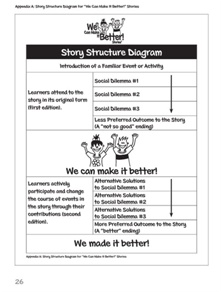 Appendix A describes the story structure. The first edition contains the social dilemmas, while the second provides solutions so the ending is a preferred ending.
Appendix A describes the story structure. The first edition contains the social dilemmas, while the second provides solutions so the ending is a preferred ending.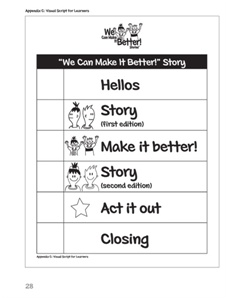 Appendix C provides a visual script for the lesson.
Appendix C provides a visual script for the lesson.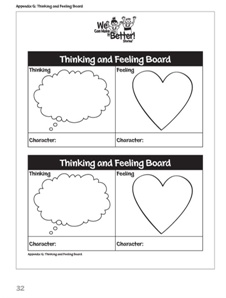 Appendix G provides a visual link between people’s thoughts and their feelings. This could be a very powerful and versatile tool. It could be used for far more activities than just the lessons in this program.
Appendix G provides a visual link between people’s thoughts and their feelings. This could be a very powerful and versatile tool. It could be used for far more activities than just the lessons in this program.